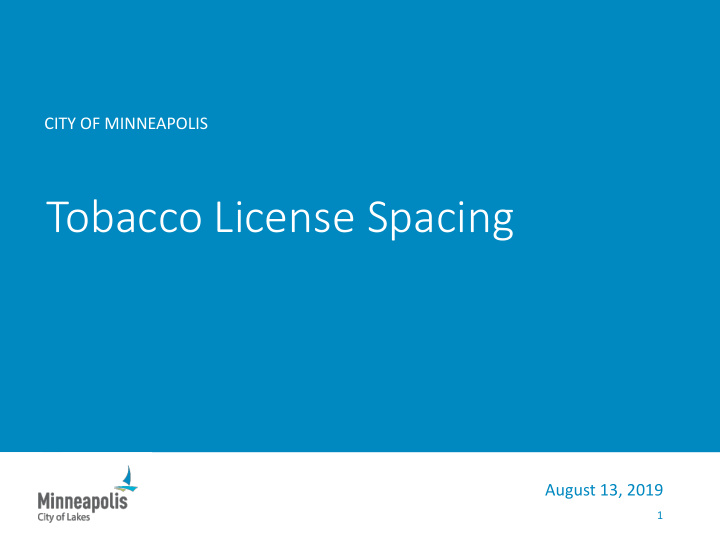



CITY OF MINNEAPOLIS Tobacco License Spacing August 13, 2019 1
Tobacco S o Shop op M Morator orium • Menthol tobacco sales restriction took effect in August of 2018 • This ordinance prohibited sales of menthol tobacco in convenience stores and limited sales to adult-only tobacco products shops and liquor stores • Many new tobacco products shops were created to allow proprietors to continue selling menthol tobacco • In August 2018, Council Member Cano introduced a moratorium on the creation of new tobacco products shops • CPED staff were authorized to conduct a study to address the issues that led to the adoption of the moratorium 2
Consequences o of the Menthol O Ordinance • Increase in tobacco products shops The number of tobacco shops increased from 25 in 2017 to 52 • today In 2016, menthol tobacco was sold in 342 retail locations while • today menthol tobacco is sold in 82 locations • Increase in availability of flavored tobacco products With additional tobacco products shops, flavored tobacco is • available in more places • Increase in rezoning requests in order to establish new tobacco products shops Tobacco shops are not allowed in the C1 or OR zoning districts • which has resulted in a number of rezoning requests 3
4
Menth thol ol T Tobacc cco A Availability ity Changes in tobacco dealer types and availability of menthol and other flavored tobacco products 400 350 300 250 200 150 100 50 0 2015 2017 2019 Tobacco dealers Exclusive tobacco shops Availability of menthol Availability of flavored 5
Distribution of Tobacco Shops Low income neighborhoods are more likely than higher income neighborhoods to have a higher density of tobacco dealers 6
Study • Examined the unintended impact of the menthol ordinance • Evaluated policy options that would help uphold the original intent of the menthol ordinance • Peer cities research for policy options • Outreach to convenience store owners 7
Study • Recommended strategies include the following: • Minimum spacing distance between tobacco products shops • Capping the number of tobacco licenses • Combination of spacing and capping • Eliminate all flavored tobacco sales in Minneapolis 8
Minimum S Spacing ng R Requ quirement • Benefits Prevent the further concentration of tobacco products shops • in any area of the city Evidence that spacing can reduce retailer density in the • lowest income neighborhoods Could reduce tobacco use over time since location and • density of tobacco shops influence tobacco use, initiation by youth and cessation • Challenges Would require additional staff analysis for each new tobacco • shop Creates de facto monopolies for the owners of existing • tobacco shops by eliminating nearby competition Creates another level of complexity for small business • owners 9
Minimum S Spacing ng R Requ quirement • Staff is recommending the adoption of an ordinance that would require a minimum spacing requirement between stores that can sell menthol tobacco, which includes tobacco products shops and liquor stores • Maps have been created showing the locations where tobacco products shops could be established under three spacing scenarios 10
11
12
13
Staff ff R Reco commendation • Staff is recommending a 2,000 foot spacing requirement between tobacco retailers that sell menthol • 2,000 feet is the same spacing requirement for liquor stores that has historically been used in the City of Minneapolis • 2,000 feet will allow for additional tobacco products shops in limited locations, preserving a business opportunity • The spacing requirement will prevent the concentration of tobacco products shops in any one area • The spacing ordinance would exempt B4 (downtown) zoning districts in the same way the liquor ordinance does 14
Recommend
More recommend